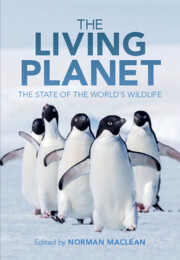Book contents
- The Living Planet
- The Living Planet
- Copyright page
- Contents
- Contributors
- Preface
- Acknowledgements
- One Introduction and the Evolution of Life on Earth
- Two Flowering Plants
- Three Bryophytes and Pteridophytes: Spore-Bearing Land Plants
- Four Terrestrial Mammals
- Five Marine Mammals: Exploited for Millennia, But Still Holding On
- Six How Birds Reveal the Scale of the Biodiversity Crisis
- Seven Reptiles
- Eight Amphibians
- Nine Freshwater Fishes: Threatened Species and Threatened Waters on a Global Scale
- Ten The Amazing Yet Threatened World of Marine Fishes
- Eleven Insects
- Twelve Marine Invertebrates
- Thirteen Non-Insect Terrestrial Arthropods
- Fourteen Terrestrial Invertebrates Other Than Arthropods and Molluscs
- Fifteen Non-Marine Molluscs
- Sixteen An Account of the Diversity and Conservation of Fungi and Their Close Relatives
- Seventeen Simple Life Forms
- Eighteen Assessing Species Conservation Status: The IUCN Red List and Green Status of Species
- Nineteen Problems with the World’s Ecosystems: The Future and Attempts to Mitigate Decline
- Twenty Conservation Methods and Successes
- Twenty One What Does the Future Hold for Our Planet and its Wildlife?
- Species Index
- Subject Index
- References
Four - Terrestrial Mammals
Published online by Cambridge University Press: 13 April 2023
- The Living Planet
- The Living Planet
- Copyright page
- Contents
- Contributors
- Preface
- Acknowledgements
- One Introduction and the Evolution of Life on Earth
- Two Flowering Plants
- Three Bryophytes and Pteridophytes: Spore-Bearing Land Plants
- Four Terrestrial Mammals
- Five Marine Mammals: Exploited for Millennia, But Still Holding On
- Six How Birds Reveal the Scale of the Biodiversity Crisis
- Seven Reptiles
- Eight Amphibians
- Nine Freshwater Fishes: Threatened Species and Threatened Waters on a Global Scale
- Ten The Amazing Yet Threatened World of Marine Fishes
- Eleven Insects
- Twelve Marine Invertebrates
- Thirteen Non-Insect Terrestrial Arthropods
- Fourteen Terrestrial Invertebrates Other Than Arthropods and Molluscs
- Fifteen Non-Marine Molluscs
- Sixteen An Account of the Diversity and Conservation of Fungi and Their Close Relatives
- Seventeen Simple Life Forms
- Eighteen Assessing Species Conservation Status: The IUCN Red List and Green Status of Species
- Nineteen Problems with the World’s Ecosystems: The Future and Attempts to Mitigate Decline
- Twenty Conservation Methods and Successes
- Twenty One What Does the Future Hold for Our Planet and its Wildlife?
- Species Index
- Subject Index
- References
Summary
Mammals are among the most recognisable and most threatened organisms on Earth. There are more than 6000 living species, ranging from the big (rhinoceroses) to the small (rats), the wondrous to the weird (even venomous, too!) (Figure 4.1). While mammals face accelerating extinction risks as human populations grow and alter the landscapes and climates of the world, hope for survival remains through productive collaborations between scientists, governments and most importantly, local communities and stakeholders.
Keywords
- Type
- Chapter
- Information
- The Living PlanetThe State of the World's Wildlife, pp. 65 - 86Publisher: Cambridge University PressPrint publication year: 2023

